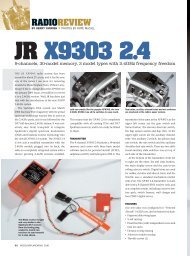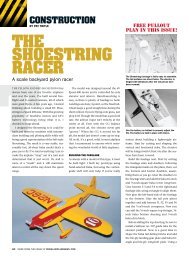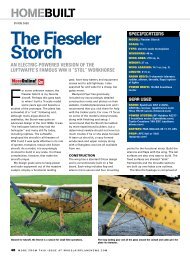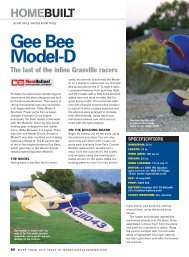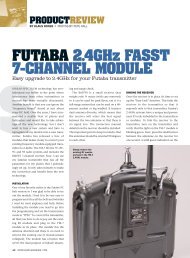Create successful ePaper yourself
Turn your PDF publications into a flip-book with our unique Google optimized e-Paper software.
Glass cloth will not take<br />
to sharp corners, so I filled<br />
these with a mixture of resin,<br />
chopped strands and a thickening<br />
agent. A generous<br />
layer of this mixture will prevent<br />
any cloth from showing<br />
through. It also helps to flatten<br />
out any irregularities in<br />
the compound. Use only aircraft-grade<br />
epoxy; it's much<br />
easier to work with and it<br />
leads to better results.<br />
Immediately following<br />
the resin/fiber mixture,<br />
I applied the layers of glass<br />
cloth that would form the<br />
mold. I try to minimize the<br />
amount of resin; the cloth<br />
reaches its maximum<br />
strength once it's completely<br />
soaked. Any excess resin<br />
only adds weight. The first<br />
layer of cloth can be laid on<br />
the mixture with almost no<br />
resin at all. I added subsequent<br />
layers of cloth until it formed a rigid mold. For small items like<br />
this, I stick to a wall thickness of %2 to % inch; this requires approximately<br />
five layers of 1 -ounce cloth. I always let the cloth cover a fairly<br />
wide area (about 1 inch) around the plug, as the second half will be<br />
formed against this and will require trimming after the moldings have<br />
cured. This photo shows the final stage of the first half of the mold.<br />
|=| When the first half<br />
had fully hardened,<br />
began the second half<br />
of the molding. Never<br />
remove the molding<br />
from the support or the<br />
first half of the molding<br />
from the plug in the<br />
early stages; patience<br />
is the key to this<br />
process! I carefully<br />
removed the blade from the support and cleaned off any excess<br />
clay. This photo shows part of the newly formed flange in black,<br />
with all of the clay still stuck to the blade and flange. Thanks to<br />
the release agents, it was easy to remove.<br />
Next, I used a Dremel saw to cut<br />
off any excess cloth. To ensure a<br />
proper fit, I drilled some 1/8-inch<br />
blind holes into the flange,<br />
spaced about 3 inches apart.<br />
This will act as a lock when forming<br />
the second half of the mold.<br />
Commercial pins are available as<br />
well, but for small items like<br />
these, I generally stick to this<br />
method. Once again, I liberally<br />
treated the plug and flange with<br />
release agents before moving<br />
on to the next step.<br />
l For the second side<br />
of the molding, I<br />
simply repeated all of the<br />
previous steps. Here, I've<br />
just applied the glass cloth<br />
to the molding compound<br />
to begin forming the second<br />
half of the mold.<br />
When they were fully<br />
cured, I drilled the<br />
moldings through while<br />
they were still attached<br />
to the plug; this ensures<br />
maximum accuracy.<br />
I then trimmed off the<br />
excess cloth and<br />
separated both halves<br />
from the plug. For the<br />
first splitting, I normally<br />
use some warm water<br />
to dissolve the PVA; an old credit card carefully placed in between<br />
the flanges can also be beneficial. Never use metal tools or brute<br />
force! Usually, the plug just falls off. In this photo, I had just<br />
removed the two halves from the plug.<br />
Because you must close the mold while the cloth is still<br />
wet, it is essential that the cloth fit the molding exactly.<br />
Pictured here are two layers of 0.4-ounce cloth together<br />
with a non-woven surface cloth. The black shoelace is, in fact,<br />
carbon roving, which I later laid around the blade's perimeter.<br />
Making the actual<br />
prop is basically<br />
just a variation of<br />
the molding<br />
process, beginning<br />
with the application<br />
of the wax and<br />
PVA; the primary<br />
distinction is in the<br />
outside coating.<br />
Though gelcoat is the most common choice, you can also use a<br />
good quality epoxy-based paint. I brushed on two coats of yellow<br />
Hobby Poxy. Once it had hardened to the point that it was sticky, I<br />
brushed in some slightly thickened resin.<br />
JUNE2DD2 69








